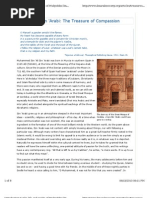The Mysticism Of Hamzah Fansuri Pdf

Course of Southeast Asian Islam, especially in Islamic mysticism (Sufism). The enigmatic 16th-century Sufi Hamzah Fansuri, for instance, a major figure of. Malay-Indonesian Sufism and literary heritage and still one of those Muslim writers dearest to Malay-reading Muslims today, appears to have displayed certain Shi'ite. (1970) the Mysticism of Hamzah Fansuri - Download as PDF File (.pdf), Text File (.txt) or read online. Ḥamza al-Fanṣūrī. Alexander Wain. Ḥamza al-Fanṣūrī is the first identifiable Southeast Asian Islamic scholar to leave behind a substantial and systematic body of. 1 See Hamzah Fansuri, The Poems of Hamzah Fansuri, ed. Mysticism is largely derived from the thought of medieval Sufi, Ibn 'Arabī (d.1240).
Options for accessing this content: • If you are a society or association member and require assistance with obtaining online access instructions please contact our Journal Customer Services team.. • If your institution does not currently subscribe to this content,. • Login via other institutional login options. • You can purchase online access to this Article for a 24-hour period (price varies by title) • If you already have a Wiley Online Library or Wiley InterScience user account: login above and proceed to purchase the article. • New Users: Please register, then proceed to purchase the article.
Syed Muhammad Naquib al-Attas, born September 5, 1931 in Bogor, Java, is a prominent contemporary Muslim thinker. He is one of the few contemporary scholars who is thoroughly rooted in the traditional Islamic sciences and who is equally competent in theology, philosophy, metaphysics, history, and literature. His thought is integrated, multifaceted and creative. Al-Attas’ philosophy and methodology Syed Muhammad Naquib al-Attas, born September 5, 1931 in Bogor, Java, is a prominent contemporary Muslim thinker. He is one of the few contemporary scholars who is thoroughly rooted in the traditional Islamic sciences and who is equally competent in theology, philosophy, metaphysics, history, and literature. His thought is integrated, multifaceted and creative.
Al-Attas’ philosophy and methodology of education have one goal: Islamization of the mind, body and soul and its effects on the personal and collective life on Muslims as well as others, including the spiritual and physical non-human environment. He is the author of twenty-seven authoritative works on various aspects of Islamic thought and civilization, particularly on Sufism, cosmology, metaphysics, philosophy and Malay language and literature. Al-Attas was born into a family with a history of illustrious ancestors, saints, and scholars. Best Animated Desktop Wallpaper For Windows 7. He received a thorough education in Islamic sciences, Malay language, literature and culture. His formal primary education began at age 5 in Johor, Malaysia, but during the Japanese occupation of Malaysia, he went to school in Java, in Madrasah Al-`Urwatu’l-wuthqa, studying in Arabic. After World War II in 1946 he returned to Johor to complete his secondary education.
He was exposed to Malay literature, history, religion, and western classics in English, and in a cultured social atmosphere developed a keen aesthetic sensitivity. Sonic Reality Sonik Synth 2 Free Download there. This nurtured in al-Attas an exquisite style and precise vocabulary that were unique to his Malay writings and language.

After al-Attas finished secondary school in 1951, he entered the Malay Regiment as cadet officer no. There he was selected to study at Eton Hall, Chester, Wales and later at the Royal Military Academy, Sandhurst, England (952 -55). This gave him insight into the spirit and style of British society.



